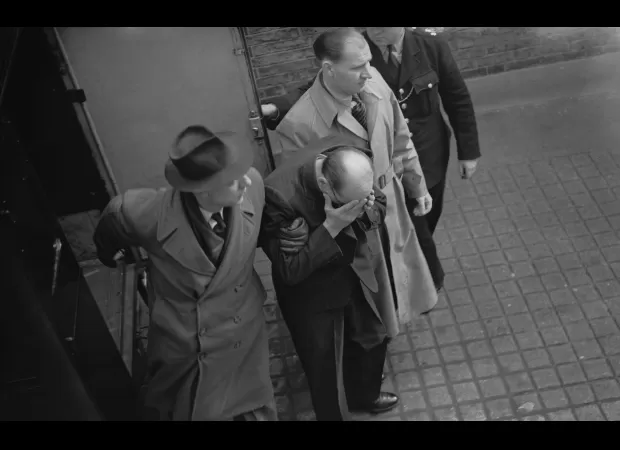A middle-aged man transformed his London home into a cemetery.
If Christie were alive now, he would be caught quickly.

John Christie, a notorious serial killer from the 1950s, was seen arriving at court in London to face charges of murder. The location of his crimes was a seemingly ordinary house at 10 Rillington Place in Notting Hill, its shabby appearance blending in with the rest of the street. However, inside the walls of this house were hidden dark and disturbing secrets. Bodies of his victims were discovered buried in the garden, beneath the floorboards, and even in the kitchen cupboards.
This house, now demolished, was the home of John Christie and his wife Ethel. Christie, a former clerk and special constable, was known for his sexual assaults and murders of seven women that took place within the walls of 10 Rillington Place over a period of ten years. The couple's marriage was said to be rocky and Christie had a history of petty crimes and violence towards sex workers.
Christie's descent into murder began in 1943, when his wife Ethel went away to visit relatives. His first victim was Austrian nurse Ruth Fuerst, who also worked as a sex worker. He lured her back to his flat and then strangled her, burying her body in the garden. Christie later confessed that he experienced a strange thrill during the act, as he could only achieve sexual satisfaction through violence and control.
His second victim, a colleague named Muriel Eady, fell prey to his deadly tactics a year later. Suffering from bronchitis, she visited Christie for a supposed medical treatment, but was instead given a lethal concoction of gas and balsam. As she lay dying, Christie raped and strangled her before burying her in the garden next to Ruth.
It would be five years before Christie struck again, this time taking the lives of his neighbor Beryl Evans and her baby daughter Geraldine. The couple had a volatile relationship and when Beryl became pregnant, Christie offered to perform an abortion against her husband's wishes. Instead, he drugged and raped Beryl before killing her and her baby.
When Beryl's husband Timothy returned home and found the bodies, he panicked and fled, later confessing to the police that he had accidentally killed them. However, his story changed multiple times and he was ultimately found guilty and hanged for the murders. During the trial, Christie gave evidence and claimed to have heard noises of bodies being dragged in the flat above.
This case became one of the most controversial and debated of the 20th century. Despite Christie's conflicting stories, Timothy was found guilty and hanged. It is unclear whether Christie's tears during the sentencing were out of relief or conscience. His motives for committing these heinous crimes are still a mystery, but according to crime expert David Swindle, some people are born inherently evil and capable of such atrocities. He also notes that many killers, like Christie, are able to blend into society and carry out their crimes unnoticed due to their cunning and organization.
John Christie arriving at court in London to face charges of murder in 1953 was a moment of great significance for both the citizens of London and the world. The notorious serial killer, who had terrorized the city for over a decade, was finally being brought to justice. As he stepped out of the police van and into the courthouse, the people couldn't help but feel a sense of disgust and fear at the sight of him.
But behind the unassuming facade of 10 Rillington Place, where Christie and his wife Ethel had resided, lay a house of horrors. The bodies of his victims were found hidden in the garden, beneath the floorboards, and even in the kitchen cupboards. It was a place that seemed like any other terrace on the street, but held dark secrets within its walls.
The story of John Christie's crimes began in the 1930s when he moved to the flat at 10 Rillington Place with his wife. It was known that the couple had a troubled marriage and Christie had a history of criminal activities and a particular fondness for sex workers. However, it wasn't until 1943, when his wife was away visiting relatives, that he committed his first murder.
His victim was Austrian nurse and sex worker, Ruth Fuerst. After luring her back to his flat, Christie strangled her and buried her body in the garden. It was a disturbing pattern that would continue for the next decade, with Christie claiming the lives of seven women within the walls of his home.
According to reports, Christie later confessed to feeling a "strange, peaceful thrill" during the act of murder, as it was the only way he could attain sexual potency. In 1944, he killed his colleague Muriel Eady, who had come to him seeking medical advice for her bronchitis. Christie tricked her into inhaling a lethal concoction and then raped and strangled her.
The next victims were Beryl Evans and her baby daughter Geraldine, who lived in the flat above Christie and his wife. When Beryl became pregnant, Christie offered to give her an abortion, but instead, he killed her and her daughter with carbon monoxide and strangled them. Her husband Timothy Evans, who returned home to find their bodies, confessed to the crime under duress and was later found guilty and hanged.
It wasn't until 1953, when Christie was finally brought to court, that the truth about his horrific crimes was revealed. The trial was highly controversial, with Christie's conflicting stories and the fact that an innocent man had been executed for his crimes. It was a case that shook the world and raised questions about the nature of evil.
According to crime expert David Swindle, some people are simply born evil and cannot be stereotyped. He points to other notorious serial killers like Ian Brady and Peter Tobin, who were able to blend into society and commit their crimes undetected. As the trial of John Christie came to an end, the citizens of London were left with a sense of horror and disbelief at the atrocities that had taken place at 10 Rillington Place. It was a place that would forever be associated with the darkest side of human nature.






